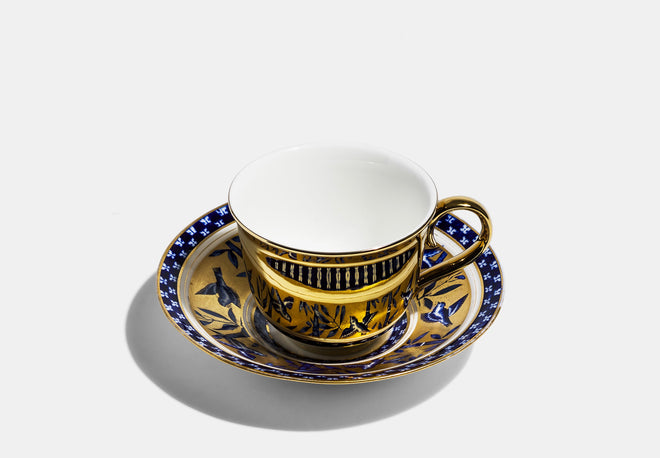
23/09/24
Reflecting the past (continued...)
Occasionally you have those moments in your life, or your business, where a good idea turns in to something really special. For me, it first happened with the Reflect Collection, realising that there were piles and piles of beautiful, intricate and detailed antique saucers which, at some point over the course of the last 200 years had become separated from their corresponding cup, rendering them virtually without any usefulness in this world. Cups are picked up, put down, have boiling water put in them regularly, and are constantly being washed and dried, so break far more regularly than their matching saucers which simply sit on the table looking pretty. But the saucers themselves can be incredibly beautiful with a huge amount of hand-painted detail and artistry. I had the idea to create a mirrored cup to reflect these incredible patterns back, bringing the saucers to life again giving them a new home in the modern world.
Having a tea or coffee from one of these sets, for me, is like being transported back in time. I get to interact with a piece of bone china that has been entirely made by hand here in the UK, with many of them being intricately decorated by hand before they would have even had electricity in the factories. When you really inspect them and get in to the detail, you can see the expertise of the decorators who would often use single hair brushes for the most intricate designs, especially in gold. Drinking from one of these sets really changes that cup of coffee, for me.
Japanese influence was such an important part of the development of the artistry of British bone china, particularly in the 19th Century. Practically every manufacturer had their own version of a Japanese pattern - often called 'Imari' which broadly followed a set of rules with regards to colours and overall composition. Some makers followed the rules, but there are so many incredible examples of artists completely breaking them, too, creating a completely new style all of their own. I have selected a few patterns which are deeply inspired by Japanese artwork but which I think have an added 'wow' factor.

Japanese Grove - Coalport c.1880
Designed for Coalport by Thomas Blocksidge circa 1880, this 'Japanese Grove' design helped cement the factory as one of the leading potters of the 19th and 20th centuries. Saucers in the ‘Japonism’ style became immensely popular in the 1870s as trade relations with Japan were restored, leading to an influx of oriental patterns flooding the Western market. Here we see beautiful bamboo with birds flying around, all flooded with rich gold which is in exquisite condition for its age.

This Japanese-inspired pattern has vines of elegant disc-shaped flowers emanating from a central tureen is typical of the Minton style in the mid-19th Century, with its clean and distinctive blues which are highlighted by the white bone china body. The flower forms, travelling tendrils and subtle asymmetry are all beautiful interpretations of traditional Japanese styling.

A fantastic example of the Imari style, the asymmetrical design on this saucer has much of the deep cobalt, vibrant coral and brilliant gold decoration that was so iconic from Stoke-On-Trent in the early 19th Century. This full and overflowing pattern, with literally hundreds of hand-painted details, takes the Imari inspiration and explodes it in to a new era of creativity.















































